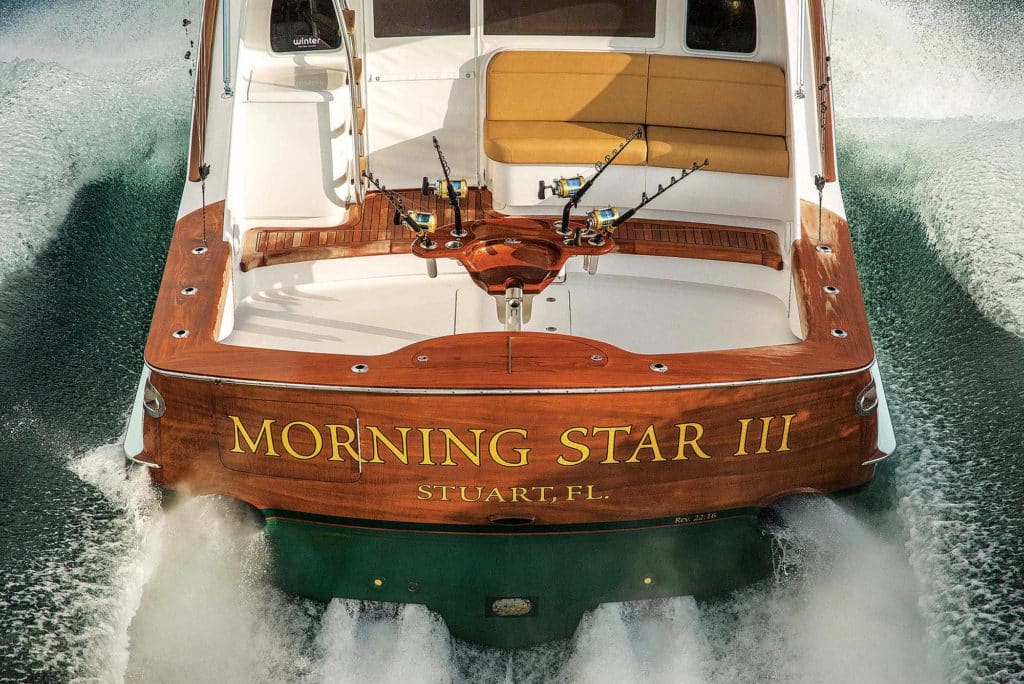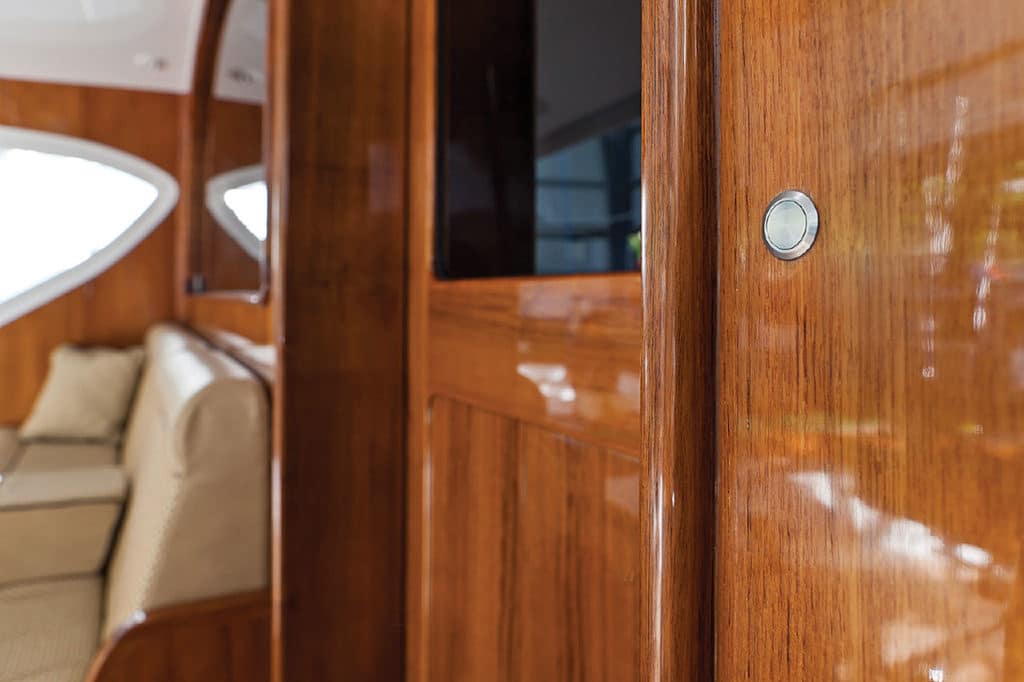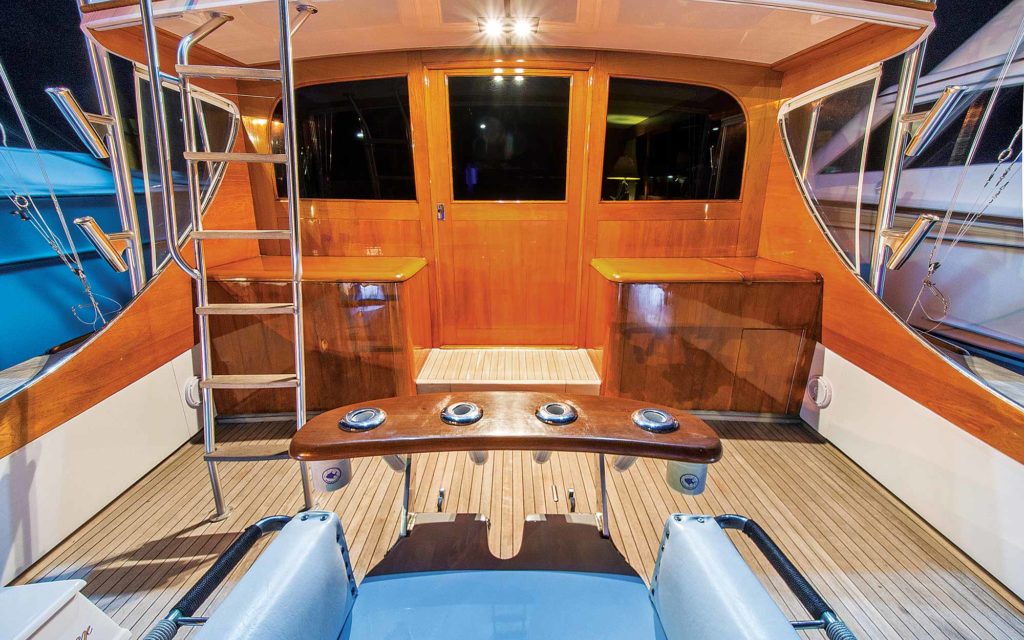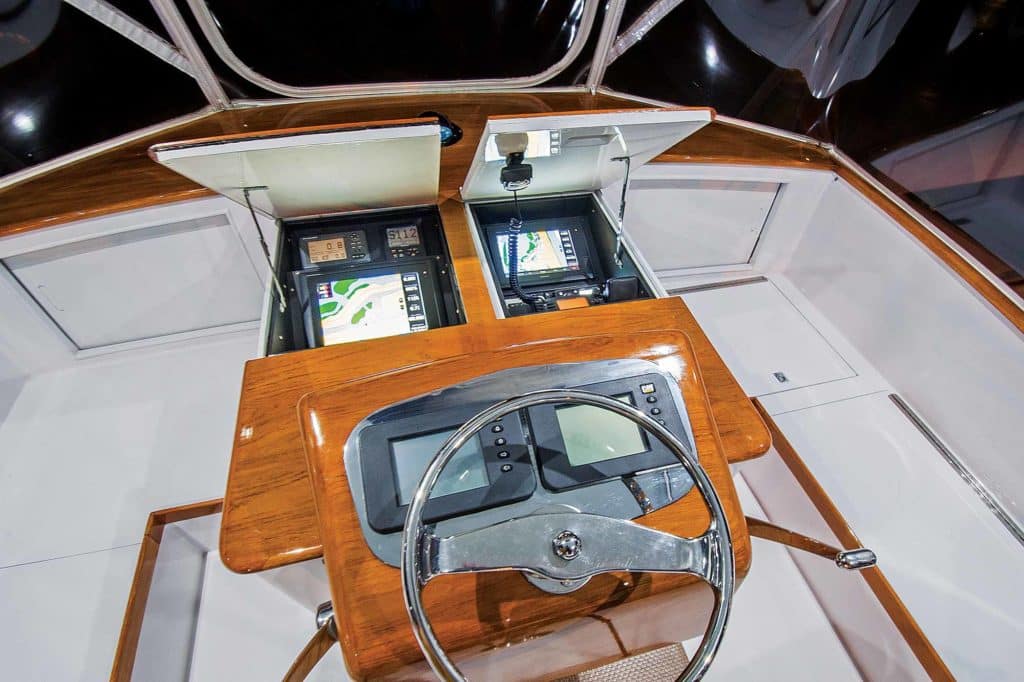
Teak has long been a staple on boats of all sizes. A durable, hard, cleanable timber, exposed raw teak has served as the safest of all deck surfaces on sailing, cruising and fishing boats for literally hundreds of years. The beauty of teak is that it also can be sealed and coated; with a quality piece of teak and actual varnish, this can expose the various beautiful shades of red, gold, brown and tan as well as the natural movement and grain of the timber.
Teak is an ideal wood to use as trim accents to break up large spans of paint known as brightwork. Trim pieces found on most custom boats and some production boats, such as the half round at the top of the house, aft bulkhead, helm pod, bridge cap rail, toe rails and cockpit coamings, can all be sealed with multiple coats of varnish for a warm, classic, upscale look.
Many sport-fishing boats do not use teak on the cockpit sole because of cost and maintenance. However, as with most things, there are several trade-offs. A teak deck offers much better footing than a fiberglass nonskid deck, and for the most part, it also hides footprints when getting on and off the boat. Teak decks also reduce glare and reflection in the cockpit, a welcome benefit for any fishing crew that spends hours scanning the spread. Maintenance of a teak deck is really very nominal, especially when fishing a lot. We have found that once the deck is cleaned and brightened, using a cleaning pad across the grain at the end of the day keeps the teak looking fresh and clean until the next time it needs to be cleaned to remove the gray tone and any dirt.
The varnish side of maintenance is similar to waxing, and no matter what the surface, it has to be maintained. If varnish is kept up properly it is not a terribly cumbersome job. We have found that once stripped and sealed and multiple coats of varnish are applied to build up the coverage and then covered with a clear coat, the varnish will last much longer. However, you must re-coat before the first signs of crazing appear; in the Florida sun, that may be as short as eight months or as long as 11 months.
We use a high-quality varnish that builds up, exposes and maintains the many colors of the teak, as opposed to just applying the clear coats. Simply applying a two- or three-part clear coat will change the color of the teak, lightening and yellowing over time or muting the colors to a monotone look. This is similar to many of the fighting chairs you see, which are coated with epoxy and have a lifeless deep-brown appearance.

Using Pre-Made Teak Panels
One cost-cutting solution is the use of pre-manufactured decks and interior floors of natural teak. Teakdecking Systems, from Sarasota, Florida, has a massive factory that allows it to inventory huge quantities of Asian teak timber where they store, age, dry and mill it. The company then assembles panels cut to the exact shape needed for decks, covering boards, interior flooring, you name it.
It can run lengths up to 40 feet long that can be shaped to match the curve of any vessel through its patented shaping process. It mills the battens, arranges by length and lays out the section, then applies a custom-blended watertight epoxy backing to secure the panel together. They are degreased and prepped with a bond breaker tape to assure proper adhesion of the caulk. Once caulked, the panels are stored to allow the caulk to cure properly. Once dried, they are sanded and the final details, such as drains, hatch trim and other details, are drawn out prior to final cutting of the deck and trim pieces. When complete, the panels are ready for installation on the vessel. This product allows builders and boatyards to continue working on other parts of the vessel without interruption from closing off the deck areas, which is necessary when installing a piece-by-piece teak deck. This is incredibly smart for interior flooring sections because the finished prefab panels can be installed in a very timely manner.

Using Recycled and Composite Teak Products
A new product on the market is from a company called EuroDesign, from Indonesia. The company’s composite teak decking was created for pool decks and marina dock decking for a project in Dubai, United Arab Emirates. The composite product is made of 60 percent recycled teak, 30 percent recycled plastic and 10 percent binding material. Interestingly, colors can be added to create the color of your choice but two standard colors are offered: teak brown, which is a cleaned teak color, and weathered gray, which has the dull gray/silver look of teak that has not been cleaned for some time and has been exposed to the elements.
This teak look-alike product can also be built in pre-manufactured panels and features properties of durability and low maintenance. It can come with or without caulk, allowing you to get large spans with no separation or seams. It has an epoxy net backing as a stiffener and moisture barrier, and installation of the panels or battens is done in the same way as real teak decking. The density of this composite is twice as much as solid teak, so it is made very thin, just 0.157 inch.

The Painted Faux-Teak Fad
The first time I personally saw a faux-teak painted transom was some 10 years ago when Roy Merritt had his 33-foot Caliban transom painted to look like traditional teak. Always looking for ways to reduce build time and maintenance, it took Merritt a while to get the process accepted on a new boat, but now it is standard practice for many builders. At first, I was skeptical of his brainstorm, but once completed, the results on the 33 were impressive. It became a bit of a game to challenge people to find the faux transom as they walked the line of boats under the shed at the storied Merritt’s Boat and Engine Works in Pompano Beach, Florida. No one picked that transom as the counterfeit one.
The benefits of the faux-teak paint job are the cost savings of timber and continued annual maintenance. Applying the faux paint to cap rails, half round, transoms and toe rails is now becoming common practice. Of course, the faux job is only as good as the painter. The critical thing is to get the base color correct; I have seen many variations, but the darker the base, the more realistic the faux seems to be.
One thing I’ve noticed is that back in the day, the finest craftsmen at Rybovich and Merritt would go to great lengths to join boards together on transoms, helm pods or cockpit wings so that you could barely see a seam. Now, the faux-paint artists go to great lengths to show a plank seam, as to give the illusion of real teak. Go figure.
Read Next: Why Boatbuilders Use Painted Faux Teak
Make no mistake: Faux-teak painting is here to stay because it can be covered with hard topcoats and waxed just like the rest of the boat. It is a giant timesaver in the build process and also reduces the material cost of the build. With the right artist, the results are impressive.
There will always be a use for real teak on boats, but with advanced composites, creative artistry and the drive to improve the boating experience, other methods will have a larger presence in the boating world as time goes on.







